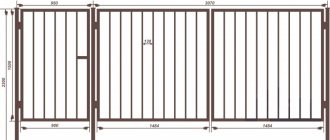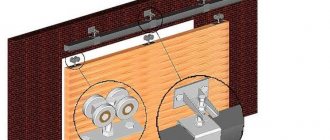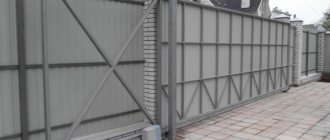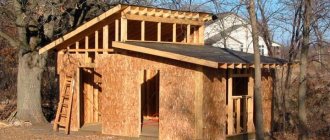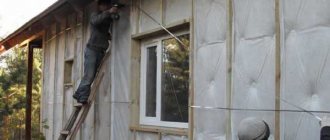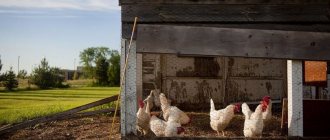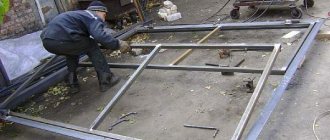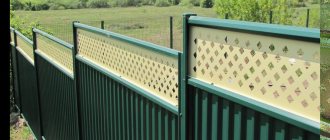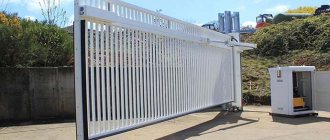Types and principle of operation
All types of sliding gates operate thanks to roller carriages and a special guide rail. The mechanism ensures not only the mobility of the canvas, but also the transfer of load to the load-bearing beams and supports. According to the type of construction, gates can be suspended, supported on a ground rail, or cantilever, that is, with a fastening system at one of the ends.
Installation of sliding hanging gates
Hanging
Such gates are often used in industrial enterprises. The canvas with rollers is suspended on a horizontal beam supported at three points. When moving, the gate moves to the side like curtains. All loads are carried by the supporting structure, which must be sufficiently powerful and stable.
The advantages of hanging gates are a high service life, a small space for rollback. Disadvantage: the top rail strictly limits the dimensions of the vehicle, which forces the installation of high poles. In suburban construction, such systems are not very popular, since they require quite a lot of materials and labor.
But if the entrance area is equipped with a canopy, it is not necessary to make new supports. You can use ready-made racks, and design a collapsible upper beam. Then, for a truck to pass, it is enough to remove the removable part and then put it in place.
With support on the bottom rail
This design is simple and reliable. The canvas moves on rollers along a guide installed at road level. There are no load-bearing beams; all the load is transferred to the ground rail and side supports. An additional roller is attached to the top of the post to hold the gate while moving.
For good gliding and uninterrupted operation of the mechanism, you need to thoroughly clear the entrance of snow, ice, and debris caused by the wind or car wheels. In private buildings, it is not always possible to maintain road clearance in perfect condition, which is why sliding gates with a bottom rail are installed in areas with little snow in winter.
Console
This type of structure is more difficult to manufacture than others, but does not have the disadvantages of height restrictions or contact with the ground rail. The roller mechanism and the support that holds it are located on the side of the opening and are fixed to a separate foundation. A cantilever beam with a sheet welded to it moves along rollers. There are catchers on the return post. The upper guide device prevents the gate from swinging.
Most often, the load-bearing beam is attached at the bottom, but there are varieties with a console at the top or in the middle. This solution is convenient if the electric drive is often covered with snow in winter. By raising it above the ground, you can get rid of this problem.
Types of cantilever gates
Advantages and disadvantages of this design
Advantages and disadvantages
Advantages:
- This gate design does not interfere with the exit/entry of a vehicle in a small area. Cantilever doors can significantly save space.
- The presence of the lower fastening of the console system allows you to equip the gate in any climatic conditions.
- The finishing can be made of different materials, for example, vertical lathing, corrugated board, forging and more.
- Possibility of choosing a design option, for example, from a sandwich panel or corrugated sheet.
- Compared to other types of gates (for example, swing gates), there is no such thing as sagging hinges. The existing automation and gate closing/opening mechanism provides for a long operational period.
- It is possible to choose different automation for gates.
Flaws:
- Unlike other types of gates, for example, swing gates, the installation of sliding gates requires more financial costs, approximately 10–20%.
- To attach the console part and the drive, it is necessary to make an additional foundation.
- You will need to allocate sufficient space along the fence.
Pros and cons of sliding gates
The main advantage is ease of use. A fairly wide gate can be opened without difficulty. There is no need to arrange a large driveway, since the canvas moves to the side.
Even in strong winds, there is no risk of spontaneous closing and damage to the vehicle. In addition, the design can be easily equipped with an electric drive. Without leaving your car, you can open the gate and enter the site.
Separately about the advantages of cantilever sliding gates:
- have no height restrictions;
- there remains a small gap at the bottom, so snow, ice or accumulated sand do not hinder their work;
- high resistance to wind loads.
The rollers that ensure the movement of the door leaf are located inside the beam, which protects the mechanism from external influences and also allows you to use the gate without unnecessary effort.
Disadvantages of console gates:
- complexity of manufacturing;
- the length of the side space for rollback is at least 1.4-1.5 times the width of the opening.
If it is not possible to provide the necessary rollback, the cantilever gate has nowhere to move. It will not be possible to install them in a short area.
What do you need to make your own gate?
1. A welding machine, a household transformer one, is quite suitable.
The welding current must be at least 130 A. Make sure that the device does not overheat during operation. It is, of course, advisable to have an inverter welder, but it costs much more. The device must have sleeves and a mask. 2. Electrodes. A pack of 3 mm universal electrodes is enough to make a gate with a wicket. 3. Grinder or cutting machine, any size.
4. Cutting wheels for a small grinder (125mm) will require about 7 + 2-3 grinding wheels.
5. Hammer.
6. Level.
7. A screwdriver with attachments for fastening corrugated sheets (or a riveter).
8. Self-tapping screws (or rivets) – 200 pcs.
9. Set of accessories for sliding gates.
10. Corrugated sheet about 10 sq.m.
11. Pipe 60*40 - 20 m.
12. Pipe 40*20 - 20 m.
13. Pipe 60*60 - 7 m.
14. Channel 16 - 20 cm, its length should be equal to half the width of the opening (if the opening is 3.6 meters, the length of the channel is 1.8 m).
15. Reinforcement with a cross section of 10 – 14 mm.
16. Paint - 1 can.
17. Primer – 1 can.
18. Solvent - 1 can.
19. Sealant.
20. Automotive anti-corrosion primer - 1 can.
As for the selection of components for sliding gates, they come in several types, depending on the weight and length of the opening of your gate and have a standard kit:
- the console (aka beam, guide) is the basis of the entire system, it is a rail inside which there are rollers, thanks to which the gate leaf can move
- two roller carriages are mounted on the foundation, the rollers themselves are located inside the console
- the upper roller prevents the door leaf from swinging and keeps it in a strictly vertical position
- the end roller prevents the sash from sagging in the closed position and fixes it
- the upper catcher “receives” the gate leaf, preventing it from warping when closing
- the lower catcher “receives” the gate leaf, preventing it from warping when closing
- Console plugs protect the console from dirt, dust, sand and moisture
Automation for sliding gates performs the function of automatically opening and closing your gate. This is not a mandatory element of sliding gates; rather, it is a step towards your personal comfort. First of all, the owner of an automatic sliding gate does not need to leave the car in order to open the gate. And, no matter whether it’s rain, snow, hail or a little rain, automatic sliding gates will save owners from having to bother with opening the gate. To avoid any problems with your sliding gates in the future, it is better to worry about choosing the right automation in advance. Just as in the choice of components for sliding gates, the choice of automation depends on the weight and length of your gate, as well as on the frequency of use of the gate. This will determine how much power you need from the drive. Also pay attention to the different functions that different electric drives have, compare the materials from which the mechanism and housing parts are made. The standard automation kit includes:
- Electric drive - a motor that moves the gate leaf
- Toothed rack – transmits movement from the drive to the gate itself, attached to the gate leaf
- Photocells – take care of the safety of you and your car by detecting obstacles in the gate leaf. If any object is detected, the gate will stop and start moving in the opposite direction
- Control panel - used to issue commands to open and close the gate
- Signal lamp - notifies about errors in the operation of the sliding system, as well as about its movement
Now, we can move on to the description of the work. So, the first thing you need to do is calculate the weight and size of the future sliding gate. As mentioned above, this is extremely important, so you need to take it seriously. Use the rule “measure twice, cut once.” The fact is that the heavier the gate, the more durable and expensive set of fittings for sliding gates and the more powerful electric drive you will need to order. The length of the console you will need depends on the size of the gate leaf. The width of the sliding gate opening is calculated depending on what kind of car you have (car, truck) and how wide the street is. It’s best to put two sticks and try to drive between them from the side of the street - it turned out, which means that the drive should be approximately like this, and if you knocked down one of the sticks, it’s better to widen the passage. Having received the dimensions of the opening width, you need to calculate the size of the counterweight of the gate; to do this, use a simple formula: (half of 100% of the width of the gate opening is the size of the counterweight). And so, if the length of the gate opening is 4 meters, then the length of the counterweight is 2 meters, and the length of the entire gate leaf is 6 meters.
Drawings and calculations
The main condition for long and reliable operation of the gate is compliance with the fastening system, current loads and compliance with installation technology. To draw up a drawing, measurements are taken. The canvas itself is usually made according to the width of the opening plus a few cm for the side rebates. The height is determined individually, taking into account the size of the fence and the material with which the frame will be sheathed. Usually it is 1.9-2.2 m.
When calculating cantilever gates, you need to take into account that they consist of a working part, which covers the opening, and a technical one. Their total length should be 40-50% greater than the width of the opening. This proportion ensures strong fastening and proper operation of all structural elements.
The frame for the cladding is composed of a reinforced contour, intermediate posts, braces and jumpers. Their dimensions can be simply calculated according to the rules of geometry or from a drawing if it is drawn up to scale. Based on the results, fill out a table (specification), which indicates the quantity of materials and components. Now you can start purchasing.
This is what a specialist’s drawing of a sliding gate should look like:
All structural elements - supports, foundations, canvas frame, rollers, holders, mortgages, etc. - work together. Therefore, it is quite difficult to independently calculate and select characteristics. It would be optimal to use ready-made solutions presented in manufacturers’ albums or using online calculators.
Making a section with your own hands
The principle of manufacturing a sliding gate frame is the same as for swing gates.
Fundamental differences:
- one section is made;
- the frame must be light and have stiffening ribs.
For a passage 4 meters wide, a section two meters longer is made. In our case, it will be a frame 6 meters long on the bottom side and 4 meters long on the top.
The result should be a design in the form of a rectangle in combination with a triangle (in one of the parts of the gate), that is, a trapezoid.
For structural rigidity, we reinforce the frame with profile pipes in the form of a mesh and a cross. We will separately consider the possibility of installing a gate in sliding gates.
She may be:
- free-standing;
- built into the gate.
The question of the type of gate should be decided during the manufacturing process of the gate frame - whether to embed it into the leaf. For sliding gates, experts advise making a free-standing gate and purchasing it in a factory version.
This will save you from many problems, since you will receive a complete package:
- drive unit;
- closer;
- lock;
- handle.
If you decide to embed a gate into the gate, we advise you not to place it in the center of the section, but to move it one meter from the edge. The width of the gate, as a rule, does not exceed 100 centimeters. The frame for the gate should be welded separately into the frame.
The hinges are welded in such a way that the gate opens inward without interfering with the sliding of the gate. The door should be equipped with high-quality handles and a lock.
Such a gate will cost you much less than a free-standing one. One of the disadvantages of a mortise gate is that it weakens the gate structure and the presence of a threshold. After this, thoroughly clean the frame from rust and scale, prime and paint thoroughly.
How to make a gate from a profiled sheet with your own hands? Read our article about this.
You can see how to make automatic gates with your own hands in this article.
Accessories set
For standard sliding gates with a width of no more than 4 m and a weight of up to 500 kg, ready-made kits of fittings are available for sale. The set includes:
- guide beam 5-6 m long;
- 2 support roller carriages;
- end roller;
- lower and upper catchers;
- device for directing the movement of the web with 2 rollers;
- end caps for beams;
- rack.
Additionally, the kit may include adjustment stands and brackets.
With a non-standard opening exceeding 4 m, the loads will be greater, so it is better to contact specialists to calculate and manufacture the gate.
What materials are needed
Gates can be welded from steel profile pipes by connecting sections of different sizes. But now they produce special T-profiles for sliding gates, which are much more convenient to use - there is no need to weld 2 pipes around the perimeter of the frame and fill the cracks with sealant. This significantly saves time and materials, and since there is no seam itself, the corrosion resistance of the structure is simultaneously improved.
To make sliding gates you will need:
- T-profile for the external frame of the canvas (can be replaced with a 60x40 pipe and welded a 20x30 pipe to it);
- profile pipe 20x30 for racks and braces;
- pipe 60x40 mm for the cantilever part - shank;
- set of accessories.
Clean all metal, prime hard-to-reach areas with an anti-corrosion, quick-drying primer. In good weather, you can process all profiles at once.
How to make a gate
In order to make a gate, you will need the following materials:
- Rectangular pipe 60×30 mm.
- Rectangular pipe 30×20 mm.
- Corrugated sheeting painted.
- Accessories.
- Tools.
Before starting work, it is recommended to make sketches to understand how you see the structure.
In preparation for work, you need to remove the top fertile layer of soil and make markings. To do this, you will need four metal rods that will serve as beacons. We check the beacons diagonally and begin excavation work.
How to make sliding gates: step-by-step instructions
Installation of hanging or rail gates involves installing a guide on the posts at the top or bottom and attaching the roller mechanism. It is more difficult to manufacture cantilever gates, the design of which consists of a working leaf and a shank. The current forces in them are distributed in such a way that the wind loads are absorbed by the fence supports, and the consoles pulled out by the weight are taken by the platform with a separate foundation.
Do-it-yourself sliding gates: manufacturing stages
If the pillars are already ready, then the work comes down to the following:
- Preparing the opening.
- Construction of the foundation for support roller carriages.
- Frame assembly.
- Sheathing.
- Installation of fittings.
- Installation of the canvas.
- Connecting the electric drive and safety elements.
- Checking the system's functionality.
If there are no supports yet, it is necessary to install strong pillars made of brick with internal reinforcement or racks made of 80x80 mm profile pipe.
Preparing the opening
It is advisable to decide in advance which gates will be installed - swing or sliding. This determines how the fastenings for the canvas should be mounted.
When laying bricks, metal embedded parts for catchers and the upper roller guide are walled into the seams. You can secure them into a ready-made pole using strong anchors. The distance between the mortgages must correspond to the height of the gate leaf. If the supports are made of profile pipes, the fastening plates are welded after their installation.
Foundation for the support mechanism
The foundation for the console support is laid separately from the foundation for the fence. It is placed next to the opening parallel to the fence. Several solutions for foundation construction are possible:
- screw piles;
- bored piles;
- reinforced concrete monolithic support.
When choosing the type of foundation, the soil structure and freezing depth are taken into account. If the site has weak or bulk soils, it is rational to use piles. Concrete foundations work well in dense soils.
Reinforced frames for concrete foundations are made from working rods and clamps with a diameter of 16 and 10 mm, respectively.
Channel No. 20 or two parallel channels No. 10 and No. 14 are welded to the piles or reinforcement outlets. They are laid close to the post, the length of the profile is equal to 1/2 the width of the opening. The top of the structure should be located at the zero level. Subsequently, 2 adjustment platforms and 2 roller bearings will be attached to the channel.
Frame assembly
The most convenient way is assembly on a special assembly table in a workshop for the production of metal structures. In the site conditions, several blocks (beams) can be placed horizontally as a working surface, or the frame can be welded vertically.
When assembled vertically, 2 “legs” are welded to the ends of the guide beam for stability. It is leveled on block linings. Cut to the size of the opening plus the length of the shank, which should be at least 1/2 the width of the opening.
The T-profile is aligned and welded along the beam strictly in the center, stepping back from the end by the thickness of the rack. The corners of the T-posts are cut off and welded strictly vertically. Temporarily secure with a piece of pipe.
They measure the diagonals, check the geometry, weld the upper T-profile, grabbing it in several places. To prevent the structure from deteriorating, complete welding of the gate is done only after complete assembly.
Inside the frame, 2 racks are welded at equal intervals, and between them there are horizontal jumpers and diagonal braces. The frame should be rigid and stable.
For gate widths up to 4 m, the shank is made in the form of a triangle; above that, a rectangle. A large load requires high rigidity, which a rectangular console can provide.
To make the shank, a 40x60 pipe is cut to size and welded to the bottom beam and the outer post. The gate is completely scalded. Now they can be laid horizontally without fear of deformation.
If automation is to be installed, it is recommended to immediately secure the rack. Pre-tighten the bosses and grab them to the beam. Then remove the rail and weld the bosses completely. The length of the slats should be equal to the width of the opening plus 50 cm. Fill all seams with automotive polyurethane sealant. Sand the joints and coat with primer. You can paint in any way - brush, roller or spray.
Sheathing
In order to correctly adjust the rolling mechanism, it is recommended to install the infill before installing the gate in the opening. It is not forbidden to do this afterwards, since adjustment is a simple operation that can be performed with a wrench in a few minutes.
For cladding use:
- corrugated sheeting;
- metal siding;
- Euro picket fence;
- tree;
- sandwich panels;
- forged gratings.
The materials are attached to the frame with self-tapping screws or welded.
Installation of fittings and installation of canvas
The main rolling elements are rollers. They can be steel or polymer. The latter type has a silent, smooth ride.
Roller carriages are mounted on support platforms welded to the channel. To adjust the position, adjusting bolts are used. It is not recommended to weld the rollers themselves, since during operation they may need to be adjusted in some plane.
The canvas with the support beam is put on rollers, and the position is controlled using a level. Next, an upper limiter is attached to the post, protecting the gate from lateral swinging.
Installation of a plate with guide rollers
Catchers are mounted on the second post (receiving column), which will hold the canvas when closing. Limit switches are installed on the beam to reduce the load on the front carriage.
Installation of the lower catcher
Installation of electric drive and safety elements
After the mechanical part of the structure is ready, installation and configuration of the electric drive begins. It is attached to the supporting channel using brackets or a plate. The drive must be selected based on climatic conditions. In order for the device to operate flawlessly in frequent frosts below 30 degrees, the manufacturer must provide such guarantees.
Voltage drops are often observed in summer cottages, so the engine should not be too sensitive. It is better to choose a metal gearbox, not plastic. If the power is unexpectedly turned off, there is a mode switch in the drive that can be used to unlock it.
The electric drive is equipped with built-in current sensitivity, but it is necessary to provide other safety elements - photocells and signal lamps. Separate cables are laid for the drive and motion sensors. When a person or animal hits the target, the power is cut off and the reverse motion is activated. The warning light alerts road users that a car may be leaving the gate. To check the functionality, 5 test runs are carried out. If the blade moves smoothly, without stopping, the lamp and sensors react, it means the installation was done correctly.
Manufacturing of embedded structure
The embedded element or channel beam acts as a support for fastening the consoles and the automatic gate drive.
According to the dimensions of the trench, a frame of the same shape is made, welded from two vertical angles and reinforcement rods. An embedded element will be installed on top of it - a large section beam two meters long.
The structure must be durable, all its parts must be connected by welding. The workpiece is lowered into the foundation trench and filled with concrete. The concrete should not completely cover the support beam.
Important! The upper edge of the workpiece must be flush with the platform for the vehicle to enter and located exactly along the horizontal sliding line of the gate, so that there is no distortion of the canvas.
We have completed the most difficult part of the work and now we are moving on to installing gates with a factory-made wicket or assembling the frame ourselves.
Service
Regular gate maintenance is the key to long service life for sliding structures. It is not complicated; it is enough to lubricate the bearings in the rollers once a year and control the adjustment of the mechanisms. Photocells may become dirty or foggy due to humidity. They should be wiped periodically with a soft cloth.
The rack also needs to be regularly cleaned of ice and dirt. Creaking or grinding are dangerous harbingers of mechanism failure. It is not recommended to lubricate the beam with grease or lithol. Dust and sand accumulate in the thick lubricant, which can cause the gate to jam.
Wicket in sliding gates
If desired, a gate can be built into the canvas. On the one hand, this is practical, since you do not need to set the entire system in motion each time. In addition, if opened frequently, the equipment may wear out prematurely.
On the other hand, some inconveniences arise. It is difficult to carry a stroller or bicycle over a fairly high threshold, or you may simply stumble. The electric drive has a wicket passage installation mode, which can be used if necessary.
A simple and functional solution is to install a wicket outside the gate structure on separate supports. Then you can enter and exit without hindrance, and the equipment resource is not consumed.
Sliding gate device
This type of gate has the following structural elements:
- Guide beam. Takes on all their weight.
- Trolley or roller support. You need 2 of them.
- Removable end roller. When closed, it serves as a support.
- Upper/lower catcher. When the gate is closed, the lower one takes the load, and the upper one reduces the windage.
- Bracket. It is important for keeping the sash from swinging sideways.
- Stand. A support is installed on it, which organizes the movement of the sash.
Roller supports are installed on the foundation, which take on the load of the guide beam. The rollers are placed inside the supporting console.
Most common mistakes
Malfunctions during the operation of the gate may occur due to violations of the installation technology:
- Bulging or skewing of the support channel in cold weather - when the depth of the foundation under the support block is insufficient, heaving forces arise.
- The frame suffered during welding - the joints were welded in the wrong sequence. First you need to grab them, weld straight sections in short sections. Welding should be done after the frame is completely assembled.
- The gate moves unevenly - the rack is installed with mismatched teeth or the bolts have not been adjusted.
Assembly of finished factory gates
Some Russian companies offer DIY kits for assembling sliding gates. All profiles are already cut to size, components and components are designed by engineers, and a guarantee is given for the main elements. The frame can be sheathed with any material of your choice.
Of course, the kit will cost slightly more than buying metal at a metal depot. But you can save time on preparing profiles and cutting. All that remains is to assemble the structure correctly and carefully.
Foundation arrangement
The most important and time-consuming work is laying the foundation for securing the cantilever blocks, the structural part of the gate. The foundation is a rectangular block reinforced with metal.
It is installed from the inside of the fence, in the part of the opening where the door will roll back.
Important! Before starting excavation work, it is necessary to carefully calculate the dimensions of the foundation for the embedded element.
Foundation dimensions
- the length of the concrete rectangle is equal to half the width of the passage;
- width not less than 50 centimeters;
- the depth depends on the freezing of the soil plus 20 centimeters.
It is important to adhere to these exact dimensions so that your entire structure does not warp later - when the soil swells in spring, you simply will not be able to open the gate and get to your site.
We recommend making the width of the entrance opening 4 meters: an inexperienced driver will enter, and the truck will bring everything that needs to be brought. Therefore, the length of the foundation block will be two meters. The freezing depth in central Russia is about 140 centimeters. For reliability, we will deepen our block by 160 centimeters.
It is easier to make the foundation for the supports: dig holes for them to the same depth - 160 centimeters. Install the posts using a level and fill with concrete. There is a large amount of excavation work to be done - take equipment or friends to help.
In addition, it is necessary to level the area for the vehicle to enter on both sides of the gate. Remove fertile soil by 20 - 30 centimeters. Fill the area with sand and gravel, lay tiles or asphalt.
In this video you can watch instructions for making sliding gates with your own hands.
